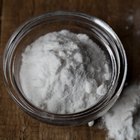
NatashaPhoto/iStock/Getty Images
The type of cocoa powder you use in a recipe can have a big effect on how it turns out, especially if you use the wrong kind. Cocoa powder comes in two distinct unsweetened varieties, normally referred to as natural and Dutch-processed. Though not necessarily interchangeable, both impart a rich, chocolate flavor to recipes as well as deliver a healthful dose of antioxidants.
Powdered Chocolate
Chocolate production starts by grinding roasted cacao beans into a thick paste called chocolate liquor. The next step involves pressing the paste between hydraulic plates. Cocoa beans contain about 50 to 60 percent cocoa butter, according to Mary Duke, Purdue University’s Consumer and Family Sciences. Pressing produces two end products, cocoa butter and cocoa powder. The grating process grinds the cocoa into the fine powder used to make unsweetened cocoa powder.
Natural Cocoa
When a recipe calls simply for unsweetened cocoa powder, it usually means natural cocoa. Intensely chocolate, bitter and slightly acidic, the complex quality of natural, unsweetened cocoa powder provides the rich, deep flavor in products such as brownies or devils-food cake. In recipes, pairing natural, unsweetened cocoa with an alkaline ingredient in the form of baking soda, helps neutralize the acidity. According to the Hershey Center for Health and Nutrition, natural, unsweetened cocoa powder can deliver up to 90 percent more antioxidants than Dutch-processed.
Dutch-Processed Cocoa
Dutch-processed cocoa, also called alkalized, unsweetened cocoa powder, appears a shade or two darker than natural cocoa and has its natural acids neutralized with an alkali. This reduces bitterness and gives it a milder, more mellow flavor. You can use chemically neutral, Dutch-processed cocoa in conjunction with baking powder or the presence of other acids in recipes. Dutch-processed cocoa also dissolves more readily than natural cocoa. Many cake mixes and other off-the-shelf chocolate products contain cocoa powder processed with alkali.
Buying and Using Cocoa
To make certain you have the right product, check the label when buying cocoa powder. Natural cocoa does not state Dutch-processed cocoa or cocoa processed with alkali on the label. Recipes will usually make it clear what type you should use, but the presence of baking soda in the list of ingredients usually requires that you use natural, unsweetened cocoa. Do not use the type of cocoa intended as a drink mix for baking by mistake; it has some cocoa powder in it, along with sweetener and powdered milk. Because Dutch-processed, natural or a blend of the two cocoas have quite a difference in taste between brands, you may have to experiment to get the flavor you're after.
Substitutions
Use the type of cocoa powder called for in the recipe if possible; substitutions aren't recommended because they can affect the way baked goods look, taste and rise. According to Fine Cooking, you can replace up to 3/4 cup of natural, unsweetened cocoa powder with Dutch-processed in most recipes, but not the other way around. If you must replace Dutch-processed, try adding a pinch of baking soda for every ounce of natural cocoa.
Related Articles

Presweetened Cocoa Powder Substitute

Nutritional Facts of Pure Cocoa

How to Substitute Cocoa Powder for ...

The Difference Between Bittersweet ...

How Many Types of Chocolate Are There?

Can You Substitute Semi Sweet Morsels ...

How to Use Cocoa Powder in Place of ...

How Many Calories Are in a Fun Size ...

Which Country Produces the Most ...

Can I Use Cumin Seeds Instead of Ground ...

Substitute for 1 Square of Baking ...

Substitution for Double-Action Baking ...

What Can You Substitute for Baking ...

Chocolate and Vitamins

Can Self Rising Flour Substitute for ...

Bread Flour vs. Cake Flour in Sponge ...

What Happens If You Use Expired Baking ...

Brandy Flavoring Substitute

Can I Make Brownies With Confectioner's ...

How to Make Prahok Sauce
References
Resources
Writer Bio
Steve Hamilton has been writing professionally since 1983. His credits include novels under the Dell imprint and for Harlequin Worldwide. A remodeling and repair specialist with over 20 years experience, he is also a Certified Pool Operator and holds an EPA Universal refrigerant certification.
Photo Credits
NatashaPhoto/iStock/Getty Images